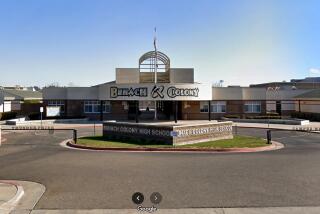Kids can dance, not ‘freak’
- Share via
The principal of a south Orange County high school has lifted a nearly three-month-long dancing ban he instituted after seeing teenagers’ sexually suggestive moves at school dances that were “one step from events that should be occurring on wedding nights.”
Principal Charles Salter, who canceled Aliso Niguel High School’s homecoming dance earlier this year, is allowing the Aliso Viejo school’s winter formal to go forward as long as students and parents sign a “contract” with a long list of admonitions. Students, parents and administrators helped craft the rules, which disallow “freak” dancing. But Salter reserved the right to cancel future dances if students fail to live up to the standards.
“I think that they’ll rise to the level of expectation,” Salter said. “All schools that are worth anything set high standards for their kids and high expectations, and you try to make sure your students reach those expectations.”
Freak dancing has gained popularity in recent years, propelled by rap music and the sexual images in hip-hop videos. Critics say the dance’s carnal positions -- girl bent at the waist, boy thrusting behind her -- go far beyond previous generations’ bumping and grinding. Clashes between adults and teens have been played out at school dances across the nation, and crested at Aliso Niguel after a jungle-themed back-to-school dance in September.
Salter had been imploring parents for months to get their children to stop freaking, and even showed a video of a school dance to hundreds of parents at back-to-school night. After the September dance, Salter canceled dances until students, parents and administrators crafted a plan to stop freak dancing.
The new guidelines forbid students from straddling each other’s legs, bending over, dancing front-to-back, grinding, touching breasts, buttocks or genitals, or “making out,” and require students to keep both feet on the floor.
The guidelines also limit dancers’ hands to their partner’s waist or shoulders.
There must be a chaperon for every 20 students, and the lights will be turned up if the dancing turns questionable, Salter said.
Students will also go through checkpoints to ensure they meet dress code standards and are sober. If a student is suspected of being under the influence, he or she will be given a breathalyzer test. School officials will also search purses and limousines for contraband.
If students break any of the rules, their parents will be called and they will be kicked out of the dance. Depending on the severity of the infraction, students could lose extracurricular privileges and face suspension or expulsion.
As school let out Wednesday afternoon, many students rejoiced that the winter formal, Feb. 10 at Camp Pendleton, was reinstated, but wondered how much fun the dance would be with chaperons watching their every swivel and shake.
“What, do we have to dance 3 feet apart and yell to our date, ‘Hey I’m having a great time’ ”? asked 15-year-old sophomore Kara Flynn, who predicted that the rules might keep students off the dance floor.
But Kara and senior Shane Flores, 17, said they were still excited that the dance was back on. “When your parents show you pictures from high school, you never see them sitting on benches eating lunch. It’s from a dance,” he said. “It’s more than a dance; it’s how you remember senior year.”
A few mothers huddled on a curb said they were relieved that their kids wouldn’t be exposed to the kind of moves featured on the lurid video the principal showed to parents.
Said Kiswati LoRusso, whose son is in 10th grade: “It was so nasty, oh my god.”
ashley.powers@latimes.com
More to Read
Sign up for Essential California
The most important California stories and recommendations in your inbox every morning.
You may occasionally receive promotional content from the Los Angeles Times.














